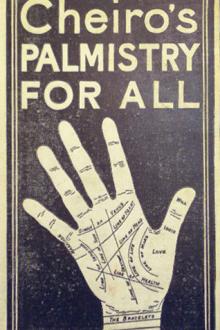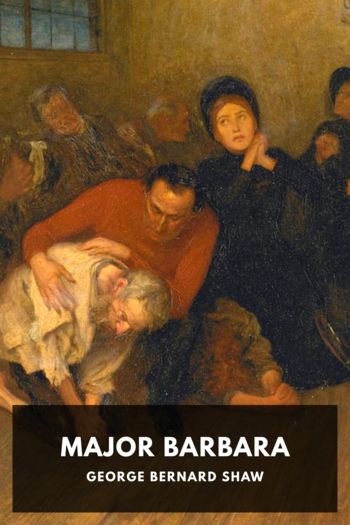Palmistry for All by Cheiro (free reads TXT) 📕

- Author: Cheiro
- Performer: -
Book online «Palmistry for All by Cheiro (free reads TXT) 📕». Author Cheiro
I have also made the following curious observation concerning the most important years in people's careers, which I now publish in this work for the first time.
People born on the 1st, 10th, 19th, and 28th of any month, and especially in the months of July, August, and January, will find the following years of their lives the most eventful:
1st, 7th, 10th, 16th, 19th, 28th, 34th, 37th, 43d, 46th, 52d, 55th, 61st, and 70th.
Those born on the 2d, 11th, 20th, and 29th of any month, but more especially in July, August, and January, will find the following years of their lives the most eventful:
2d, 7th, 11th, 16th, 20th, 25th, 29th, 34th, 38th, 43d, 47th, 52d, 56th, and 70th.
Those born on the 3d, 12th, 21st, and 30th of any month, but more especially in the months of December and February, will find the following years of their lives the most eventful:
3d, 12th, 21st, 30th, 39th, 48th, 57th, 66th, and 75th.
Those born on the 4th, 13th, 22d, and 31st, especially in the months of July, August, and January, will find the followings years of their lives the most eventful:
1st, 4th, 10th, 13th, 19th, 22d, 28th, 31st, 37th, 40th, 46th, 49th, 55th, 58th, 64th, 67th, 73d, and 76th.
Those born on the 5th, 14th, and 23d of any month, but especially in the months of June and September, will find the following years of their lives the most eventful:
5th, 14th, 23d, 32d, 41st, 50th, 59th, 68th, and 77th.
Those born on the 6th, 15th, and 24th of any month, but especially in the months of May and October, will find the following years of their lives the most eventful:
6th, 15th, 24th, 33d, 42d, 51st, 60th, 69th, 78th, and 87th.
Those born on the 7th, 16th, and 25th of any month, especially in the months of July, August, and January, will find the following years of their lives the most eventful:
2d, 7th, 11th, 16th, 20th, 25th, 29th, 34th, 38th, 43d, 47th, 56th, 61st, 65th, 70th, 74th, and 79th.
Those born on the 8th, 17th, and 26th of any month, but more especially in the months of January, February, July, and August, will find the following years of their lives the most eventful:
8th, 17th, 26th, 35th, 44th, 53d, 62d, 71st, and 80th.
Those born on the 9th, 18th, and 27th of any month, but more especially in the months of April, October, and November, will find the following years of their lives the most eventful:
9th, 18th, 27th, 36th, 45th, 54th, 63d, 72d, and 81st.
This curious system it will be seen has embraced every day of every month that people can be born on. It is based on a strange law of periodicity that after years of study I have found extremely accurate and wonderful in its meaning.
PART II—CHEIROGNOMY OR THE SCIENCE OF INTERPRETING THE SHAPE OF HANDS CHAPTER I THE STUDY OF THE SHAPE OF THE HANDWe now leave the domain of what must be considered Palmistry, the study of the Lines of the Palm—or Cheiromancy, as it was called by the Greeks from the word χεíρ, the hand, and proceed to consider the meanings that can be derived from the shapes of the hands, fingers, etc., which is called Cheirognomy.
These two studies may be taken up separately, but by a knowledge of both the student will be doubly armed, especially in the reading of character.
To a judge of horseflesh the limbs of the horse give him such a fund of information as to the animals' breed, training, etc., that it enables him to draw conclusions that he could not otherwise obtain.
In the same way the shape of the hand gives an enormous wealth of information as to breed and peculiarities of human beings.
In a book of this nature I shall be able to give only the leading traits denoted by each type, but if readers wish to carry out this study further, I must refer them to my larger works on the subject, in which the shapes of the hands are described in the fullest detail.
The most casual observation of character as shown by the formation of hands will soon convince any person of the value of this study. Even in itself it possesses the most far-reaching possibilities in helping to a clear understanding of the difference that exists in races, their various blends of types, that have now spread themselves by intermarriage and travel over the surface of the earth.
For example, the difference in the shape of the hands of the French and German or the French and English races would convince any thinking person that temperament and disposition are indeed largely indicated by the shape of the hand itself.
It is even a remarkable thing that though work and exercise may enlarge and broaden the hand, yet the type to which it belongs is never destroyed, but can be easily detected by anyone who has made a study of such matters.
The Seven Types or Shapes of Hands are as follows:
(1) The Elementary—or lowest type.
(2) The Square—or the useful hand.
(3) The Spatulate—or nervous active type.
(4) The Philosophic—or jointed hand.
(5) The Conic—or the artistic type.
(6) The Psychic—or the idealistic hand.
(7) The Mixed Hand.
As its name implies, the Elementary is the lowest type of all. It is just a little above the brute creation. This type is extremely short (Plate I., Part II.), thick set and brutal-looking. In passing I must draw the reader's attention to the fact that the shorter and thicker the hand is, the nearer the person is to the animal.
In examining this type one can therefore only expect to find it the expression of all that is coarse, brutal, and animal.
People having such hands naturally have very little mental development or ability. They are found engaged in occupations requiring only unskilled labour and the very lowest even of that.
They are violent in temper, and have little or no control over their passions or their anger. They are coarse in their ideas, possess little or no sentiment, no imagination or feeling, and it has been found that even the nerve system of such types is more or less in a state of non-development. They do not feel pain as the higher types of humanity feel it, and have little ambition except to eat, drink, and sleep.
Note.—The thumb is extremely short and low-set with the Elementary type.
Fig. 2—THE SQUARE OR USEFUL HAND. Fig. 3—THE SPATULATE HAND.
Fig. 4—THE PHILOSOPHIC HAND.
Plate I.—Part II. THE SQUARE TYPE
The Square type (Plate I., Part II.,) is so designated on account of the palm being like a square in shape, or at least nearly so. Such a hand in fact "looks square." It is rather straight or even at the wrist, at the base of the fingers, and also at the sides. The fingers themselves also have a "square-cut" appearance. The thumb is, however, nearly always long, well-shaped, and set high on the palm, and stands well out from the palm.
The Square Hand is also called the practical or useful hand. People who possess this type are essentially practical, logical, and rather materialistic. They belong to the earth and the things of the earth. They have little imagination or idealism, they are solid, serious workers, methodical and painstaking in all they do. They believe in things only by proof and by their reason. They are often religious and even superstitious, but more from habit than from anything else.
They are determined and obstinate, especially if their thumbs are long and the first joint stiff.[7]
[7] See Chapter on Thumbs, page 127.
They succeed in all lines of work that do not require imagination or the creative faculties, and as business men, lawyers, doctors, scientists, they do extremely well, and are generally to be found in such callings.
THE SPATULATE HANDThe Spatulate or active nervous type (Plate I., Part II.) is usually crooked or irregular looking, with large tips or pads at the ends of the fingers, rather like the spatula chemists use and from which peculiarity this type gets its name. The people who possess this type are in fact always "pounding" at something. They are full of untiring energy, enormous workers in everything they take up, and generally remarkable for their originality.
They are not built on the hard set square lines of the former type. These persons have enormous imagination, their creative faculties largely developed. They are inventive, unconventional, emotional, demonstrative, and in fact the complete opposite in character to the class who possesses the square type of hand.
The Spatulate type has also the palm irregular in shape. It may be wider at the base of the fingers than at the wrist, or it may be found vice versa.
In the first case they are then more practical in their work and views and less impulsive. With the larger development at the wrist, they are more carried away with their impulses, hasty and impetuous in temper, speech, and action.
THE PHILOSOPHIC HANDThe Philosophic Hand (Plate I., Part II.) received this name from the Greek φιλοσ—love, and σοφιχ—wisdom. When the Greeks made a study of hands they noticed that all those persons who possessed this type had a bent for philosophy in their blood that nothing could eradicate.
Fig. 2.—THE PSYCHIC OR IDEALISTIC HAND.
Fig. 3.—THE MIXED HAND.
Plate II.— Part II.
The Philosophic Hand is long, bony, and angular with knotty joints, and is as a general rule fairly thin. People with this type of hand are always studious. They are great readers and usually have a strong tendency towards literature. They love sedentary work, and have a somewhat lonely, ascetic disposition. Perhaps on account of this quality they are very often found in church-life, or largely associated with religious movements. The monks of old, I mean those who compiled those wonderful manuscripts on doctrine, science, art, alchemy, and occult matters, all had this class of hand. In our modern times this type may be easily recognised, and the qualities it expresses remain the same even in the age of money-getting and machinery.
It is, however, more usual nowadays to find a slight modification of the true philosophic hand in that of the hand with the palm square and with the fingers only belonging to the philosophic type. In such cases the practical nature is a basis or foundation on which the studious mind builds its theories, its religion, its literary achievements, or its scientific researches.
As a rule the Line of Head on such hands is rather sloping, but it may also be found almost straight, and when it is, a more "level-headed" disposition will make more practical use of the studious nature. But speaking generally, people with this type of hand rarely accumulate as much wealth as those possessing the Square Hand.
The knotted or jointed fingers give carefulness and detail in





Comments (0)